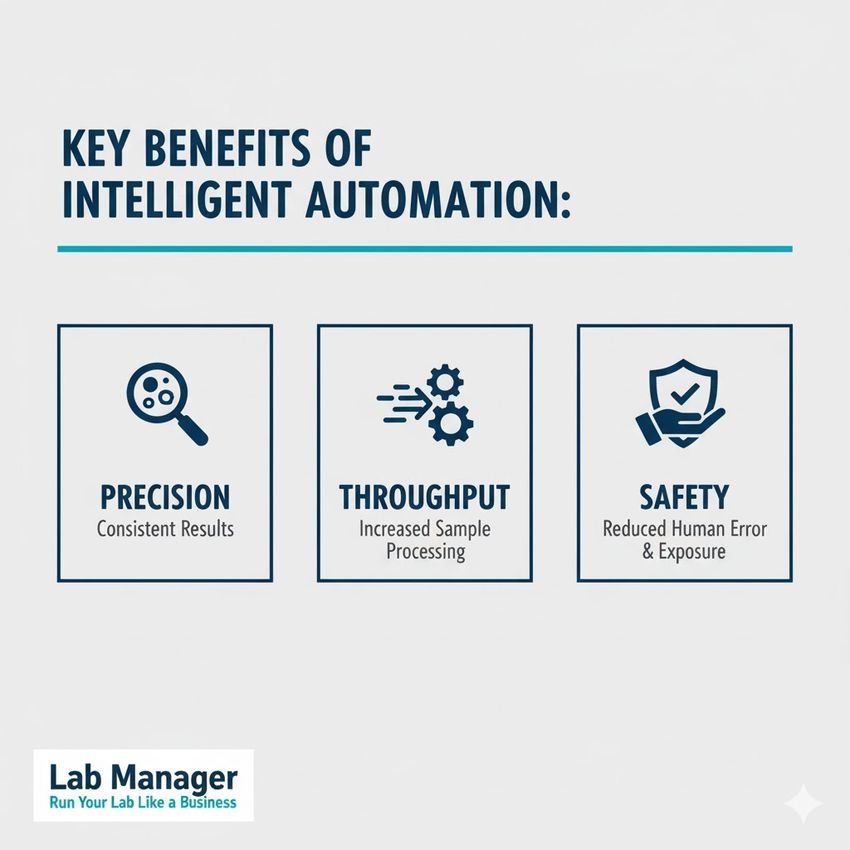The landscape of scientific discovery is undergoing rapid evolution. Technology adoption is critical for maintaining global competitiveness. Groundbreaking innovations for academic labs are fundamentally reshaping experimental design, execution, and analysis. Embracing these emerging innovations ensures that research institutions can handle the exponential growth in data volume. It also accelerates the pace of discovery across fields from genomics to materials science. Laboratories that successfully integrate these technologies achieve superior efficiency, higher precision, and a robust framework for reproducible science.
The critical role of intelligent automation and robotics in academic workflows
Implementing laboratory automation and robotics has moved from an optional upgrade to a foundational requirement for modern high-throughput research. These systems significantly mitigate the risk of human error associated with repetitive tasks. This mitigation ensures the consistency and reproducibility that underpins trustworthy scientific findings. Robotics frees highly skilled personnel from mundane tasks. Personnel can then focus on complex analysis and experimental design.
Intelligent automation systems include sophisticated robotic liquid handlers, automated plate readers, and integrated sample management systems. These modular platforms offer customizable solutions for academic settings where research needs change rapidly.
Key benefits of integrating intelligent automation:

Precision, Throughput, Safety: Intelligent automation is the critical factor in scaling up research operations and achieving consistent results.
GEMINI (2025)
- Precision and reproducibility: Robotic systems execute complex pipetting and dilution series with nanoliter precision, minimizing intra- and inter-assay variability.
- Enhanced throughput: Automation enables 24/7 operation for experiments like high-throughput screening (HTS) or large-scale genomic workflows, drastically reducing project timelines.
- Safety and ergonomics: Robots handle hazardous reagents or perform repetitive motions, reducing exposure risks and ergonomic strain on laboratory personnel.
For instance, AI-powered pipetting systems are now being integrated. This technology allows instruments to adapt protocols in real-time based on fluid dynamics or sample viscosity. This capability further optimizes volume transfers. It ensures reliable data collection, even in complex biological assays. These systems are central to maximizing resource utilization in core facilities and dedicated academic labs.
Digital transformation: the migration to cloud-based data management solutions
The proliferation of high-throughput instruments and sensors has created massive, complex data sets. Traditional paper-based methods cannot manage these sets effectively. Digital transformation involves establishing an interconnected ecosystem. In this ecosystem, all instruments, experiments, and results are linked securely and instantaneously.
The core of this digital shift is the adoption of robust, cloud-integrated software solutions like Laboratory Information Management Systems (LIMS) and Electronic Lab Notebooks (ELNs). LIMS manage sample lifecycles, inventory, and instrumentation logs. ELNs serve as the primary record for experimental design, procedures, and observations. Moving these systems to the cloud provides seamless accessibility and scalability. It also ensures effective disaster recovery.
Essential components of modern digital ecosystems in academic labs:
Component | Function | Impact on Research Efficiency |
|---|---|---|
Cloud-based LIMS | Manages samples, inventory, instrument calibration, and workflows. | Ensures traceability and optimizes resource scheduling. |
Electronic Lab Notebooks (ELNs) | Secure, real-time documentation of protocols and results with version control. | Facilitates collaboration and audit-readiness. |
Internet of Things (IoT) Monitoring | Sensors track environmental parameters (temperature, humidity, CO₂, vibration) in freezers and incubators. | Provides real-time alerts to prevent sample loss and maintains environmental compliance. |
System Integration | APIs connect instruments (e.g., sequencers, mass spectrometers) directly to LIMS/ELNs. | Eliminates manual transcription errors and enhances data management. |
This integration accelerates research. It also allows for collaborative science across different research groups or global institutions. Data becomes findable, accessible, interoperable, and reusable (FAIR). This enables advanced analytical techniques that rely on integrated, high-quality data.
Artificial intelligence and machine learning for predictive discovery in research
Automation and digital data collection set the stage for the most powerful of emerging innovations. This involves the application of Artificial Intelligence (AI) and Machine Learning (ML). These computational tools are no longer confined to theoretical modeling. They are now embedded directly into the research workflow of academic labs. They guide experimental direction and accelerate discovery.
AI algorithms can swiftly process and interpret vast amounts of experimental data. They identify subtle patterns and correlations that are imperceptible to human analysis. This capability enhances research efficiency. It also speeds up the process of hypothesis generation and validation.
Applications of AI/ML driving innovations for academic labs:
- Predictive Analytics: ML models analyze historical experimental data to forecast outcomes, optimize reaction parameters, or predict the success rate of a new compound synthesis, minimizing wasted resources.
- Generative Models: Generative AI is used to design novel molecules, materials, or protein structures with specific desired properties, opening new avenues in drug discovery and engineering.
- AI-Driven Image Analysis: In microscopy and pathology, deep learning networks automate the quantification of cells, objects, or features in complex images, offering objective and high-throughput analysis that exceeds manual capabilities.
- Virtual Advisors: AI assistants trained on proprietary datasets can provide real-time guidance to researchers, effectively serving as an instant domain expert during complex experimental execution.
The adoption of these intelligent systems transforms the scientist's role. It shifts them from a hands-on data generator to a strategic conductor. They leverage computational power to explore previously inaccessible scientific dimensions. For example, the increasing availability of affordable, benchtop sequencing tools pairs perfectly with ML. This allows for complex genomic data processing to be handled locally. (The Broad Institute offers significant resources detailing these types of genomic technology advancements.)
Lab Quality Management Certificate
The Lab Quality Management certificate is more than training—it’s a professional advantage.
Gain critical skills and IACET-approved CEUs that make a measurable difference.
Upholding data integrity and compliance in the digital era
The increasing reliance on digital records and automated processes necessitates stringent adherence to data management principles. This ensures the trustworthiness of scientific output. For academic labs involved in translational, clinical, or industry-sponsored research, regulatory adherence is non-negotiable.
The global standard for data reliability is frequently summarized by the ALCOA+ framework, which mandates that data must be:
- Attributable: Traceable to the person or system that generated it.
- Legible: Clear, readable, and permanent.
- Contemporaneous: Recorded at the time the work was performed.
- Original: The first recording of the data, or a certified true copy.
- Accurate: Correct and free from error.
- Plus (+): Complete, Consistent, Enduring, and Available.
Modern digital systems like LIMS and ELNs are engineered to enforce these principles through robust features. For example, role-based access controls ensure that only authorized personnel can make modifications. This supports the Attributable principle. Furthermore, immutable audit trails automatically record who did what and when. This ensures Enduring traceability.
Regulatory standards that guide data management in advanced academic labs:
- FDA 21 CFR Part 11: This regulation governs the use of electronic records and electronic signatures. It requires systems to maintain data integrity equivalent to that of paper records. Compliance is essential for any lab producing data submitted to the U.S. Food and Drug Administration (FDA).
- ISO/IEC 17025:2017: This international standard defines the general requirements for the competence, impartiality, and consistent operation of laboratories performing testing and calibration. It places a heavy emphasis on traceable and verifiable records for every analytical procedure.
- Good Automated Laboratory Practices (GALPs): Though older, the principles detailed in GALPs continue to provide foundational guidance on ensuring the reliability of data derived from automated systems, emphasizing accountability, documentation, and standardized procedures.
Failure to uphold data integrity risks the credibility of research. It can also lead to non-compliance penalties. Therefore, any investment in innovations for academic labs must be accompanied by comprehensive validation and training protocols.
Strategic investment in research efficiency and future readiness
Successful equipment procurement and integration of innovations for academic labs require a strategic, long-term outlook. This outlook transcends simple cost analysis. Academic institutions must evaluate new technologies based on their total impact on scientific output and operational efficiency. The adoption of modular, portable, and custom-designed equipment provides flexibility and optimizes lab space. These solutions are often enabled by emerging innovations such as benchtop sequencers or 3D-printed labware. Lab space is often at a premium in academic settings. These advanced tools, combined with robust data infrastructure, ensure that research facilities remain at the forefront of scientific possibility. Adopting these comprehensive innovations for academic labs drives the next generation of scientific breakthroughs. It also secures the institution's future in the competitive research landscape.
Frequently asked questions about innovations for academic labs
What is the most critical digital tool for improving data management in academic labs?
The most critical digital tools are the integrated Electronic Lab Notebook (ELN) and Laboratory Information Management System (LIMS). An ELN standardizes experiment documentation and collaboration. A LIMS manages the lifecycle of samples, inventory, and instrumentation, ensuring complete and centralized data management.
How do modern innovations for academic labs reduce experimental variability?
Modern innovations for academic labs, particularly intelligent laboratory automation and robotics, reduce variability by minimizing human intervention in repetitive tasks like liquid handling. Automated systems execute protocols with ultra-high precision and consistency, eliminating the common sources of error found in manual pipetting and preparation.
Is specialized training required to implement AI in academic research?
While developing AI models requires specialized data science expertise, modern products and emerging innovations are incorporating user-friendly, pre-trained AI and ML interfaces directly into LIMS, ELNs, and instrument software. This makes the power of AI-driven analysis and decision support accessible to laboratory professionals without requiring extensive computer science training.
What compliance standard is vital for labs dealing with clinical research data?
For academic labs dealing with data submitted to regulatory bodies in the United States, adherence to the principles of FDA 21 CFR Part 11 is vital. This standard mandates controls for electronic records and signatures to ensure their reliability and trustworthiness.
This article was created with the assistance of Generative AI and has undergone editorial review before publishing.














